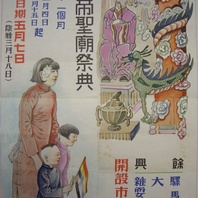
Item
Yaodi shengmiao jidian (Ceremony at the Emperor Yao Temple)
This poster was produced (almost certainly by the Japanese military) with the aim of advertising the re-opening of the Emperor Yao Temple (Yaodi shengmiao) in Linfen (Shanxi Province). This site was taken by the Japanese from communist resistance fighters, and was used by the Japanese as a symbol of the apparent iconoclasm and lack of religious sensitivity shown by the communists. The re-opening the temple to worshippers in the spring of 1938 by the Japanese was used to demonstrate the extent to which occupation supposedly included respect for Chinese religious traditions. The painted image of the female worshipper here was based on a photograph of a female worshipper at the same temple produced in other propaganda leaflets some months earlier.
Read More
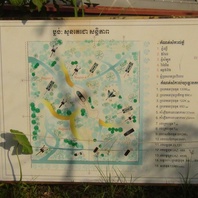
Item
Map of display of Soviet military equipment at Win-Win Monument
This photograph shows a map of the open-air display of Soviet military equipment that is located on the southern side of the Win-Win Monument complex. The Win-Win Monument complex – photographed here in January 2020 – was inaugurated in December 2018 to mark the twentieth anniversary of the end of the post-Democratic Kampuchea civil war, with the final defection of the remaining Khmer Rouge factions, thanks to the DIFID policy (“Divide, Isolate, Finish, Integrate, Develop”) also known as the “Win Win” policy of Prime Minister Hun Sen.
Read More
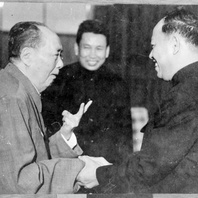
Item
Mao Zedong with Pol Pot and Ieng Sary
This picture shows Mao Zedong with Pol Pot and Ieng Sary during the visit of the Khmer Rouge leaders to Beijing in June 1975. It was featured in the publication (French and English versions) entitled The People’s Republic of Kampuchea (1979). According to the caption which accompanied the image in that publication, the photograph was part of the archives found by the Vietnamese and Kampuchea United Front for National Salvation troops at the Bureau of the Central Committee of the Communist Party of Kampuchea (Office code 870). Mao is shown congratulating Ieng Sary and Pol Pot and, according to the original caption, saying: “Comrades, you have achieved a prodigious victory. In one go, no more classes!” This photograph is part of the collection held by the Agence Khmère de Presse (AKP) and Cambodia’s Ministry of Information. This collection, which documents the early years of the People’s Republic of Kampuchea as photographed by the Vietnamese and a small team of Cambodian photographers, has not yet been classified or indexed.
Read More
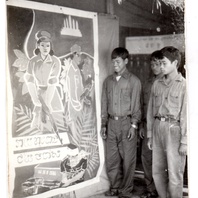
Featured Item
Three men beside a propaganda poster
This photograph shows of three young soldiers standing next to a poster representing two soldiers (a man and a woman) from the Kampuchea United Front for National Salvation (KUFNS, also known as FUNSK) [Front or Renakse] fighting against the Khmer Rouge-Chinese enemy. The three soldiers stand at the entrance to a hut. The poster is about 1.80 metres in height. It is pinned on the hut’s external wall. It shows a female soldier and a male soldier standing below the Kampuchea United Front for National Salvation flag. The female soldier points her rifle to the bottom of the poster, at the enemy. The latter is clad in black and wears a krama (traditional scarf). He is obviously a Khmer Rouge fighter. The writing in Khmer, at the centre of the poster, reads: “Fight for victory”. This photograph is part of the collection held by the Agence Khmère de Presse (AKP) and Cambodia’s Ministry of Information. This collection, which documents the early years of the People’s Republic of Kampuchea as photographed by the Vietnamese and a small team of Cambodian photographers, has not yet been classified or indexed.
Read More
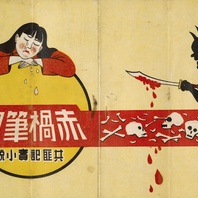
Item
Chihuo biji: Gongfei jishi xiaoshuo(A record of the Red Peril: A novel recording the deeds of the Communist bandits)
This book, almost certainly produced by the Japanese military, tells the story of communist violence against Chinese peasants in wartime Shanxi, and the escape of an anti-communist Chinese peasant girl to occupied Beijing. It was clearly written to discourage civilian support for the communist resistance in north China, and to foster peasant support for the newly-established PGROC early in the occupation. The weeping peasant woman is juxtaposed to the sinister “devil” that is international communism.